Last Updated on 6 months by Francis
Welcome to our comprehensive guide on blue and red light therapy. If you’re looking to improve your skin, boost your mood, or enhance your overall health, understanding how to use these therapies correctly is essential. In this guide, we’ll explore the benefits of blue and red light therapy and provide you with tips on how to incorporate it into your daily routine for optimal results.
Contents
Key Takeaways:
- Blue and red light therapy offer numerous health benefits.
- These therapies can be used to improve skin health, reduce pain and inflammation, and enhance sleep quality.
- Choosing the right devices and setting up a proper routine are crucial for achieving the best results.
- It’s important to understand the potential side effects and precautions before beginning light therapy sessions.
- Blue and red light therapy can be combined with other skincare practices to further enhance their effectiveness.
The Benefits of Blue and Red Light Therapy
Are you looking for a natural and effective way to improve your skin, boost your mood, and enhance your overall health? Look no further than blue and red light therapy. These therapies offer numerous benefits for both physical and mental health, and can be easily incorporated into your daily routine.
The Benefits of Blue Light Therapy
Blue light therapy has become a popular treatment for acne and other skin conditions. By penetrating deep into the skin, blue light helps to eliminate the bacteria that cause acne, reducing inflammation and preventing future breakouts.
But blue light therapy doesn’t just benefit your skin. Research suggests that it can also enhance your mood and cognitive function, making it a great option for those experiencing seasonal affective disorder or other forms of depression.
The Benefits of Red Light Therapy
Red light therapy, on the other hand, is most commonly used for its pain-relieving properties. By stimulating the production of endorphins, red light therapy can naturally reduce discomfort and inflammation in the body. It’s also been found to improve sleep quality, making it a great option for those struggling with insomnia or other sleep issues.
Additionally, red light therapy is a powerful anti-aging tool. By promoting collagen production and improving skin elasticity, it can help reduce the appearance of fine lines and wrinkles, giving you a more youthful and radiant complexion.

The Power of Combination Therapy
While blue and red light therapy offer numerous benefits on their own, they can be even more effective when used together. By combining the two therapies, you can effectively address both acne and signs of aging while also promoting pain relief and improved sleep quality.
Whether you’re seeking better skin, improved mood, or enhanced physical health, blue and red light therapy offer an all-natural and non-invasive solution. Start incorporating these therapies into your daily routine today to experience their powerful benefits for yourself.
Using Blue and Red Light Therapy for Skin
If you’re looking to improve the appearance of your skin, blue and red light therapy can be incredibly beneficial. Blue light therapy targets acne-causing bacteria and reduces inflammation, making it an effective treatment for acne-prone skin. Red light therapy stimulates collagen production and reduces the appearance of fine lines and wrinkles, making it an ideal option for anti-aging efforts.
Blue Light Therapy for Acne
Blue light therapy is a non-invasive and effective treatment for acne. The blue light penetrates the skin and targets the bacteria that cause acne, reducing inflammation and preventing future breakouts. It’s important to note that multiple sessions are typically required to see the full benefits of blue light therapy for acne.
When using blue light therapy for acne, it’s important to cleanse the skin thoroughly before each session. You can then use a handheld blue light device or visit a dermatologist for a professional session. Depending on the severity of your acne, sessions can last from a few minutes to 30 minutes, and typically require multiple sessions per week.
Red Light Therapy for Anti-Aging
Red light therapy is an excellent option for those looking to reduce the appearance of fine lines and wrinkles. The red light stimulates collagen production, which helps to plump the skin and reduce the appearance of wrinkles.
To use red light therapy for anti-aging, you can use a handheld device or visit a spa for a professional treatment. It’s important to note that consistency is key when using red light therapy for anti-aging – multiple sessions per week may be necessary to see results.
When using red light therapy, it’s important to protect your eyes with goggles and to avoid looking directly at the light. Sessions can last from a few minutes to 30 minutes, depending on the device and intensity level.
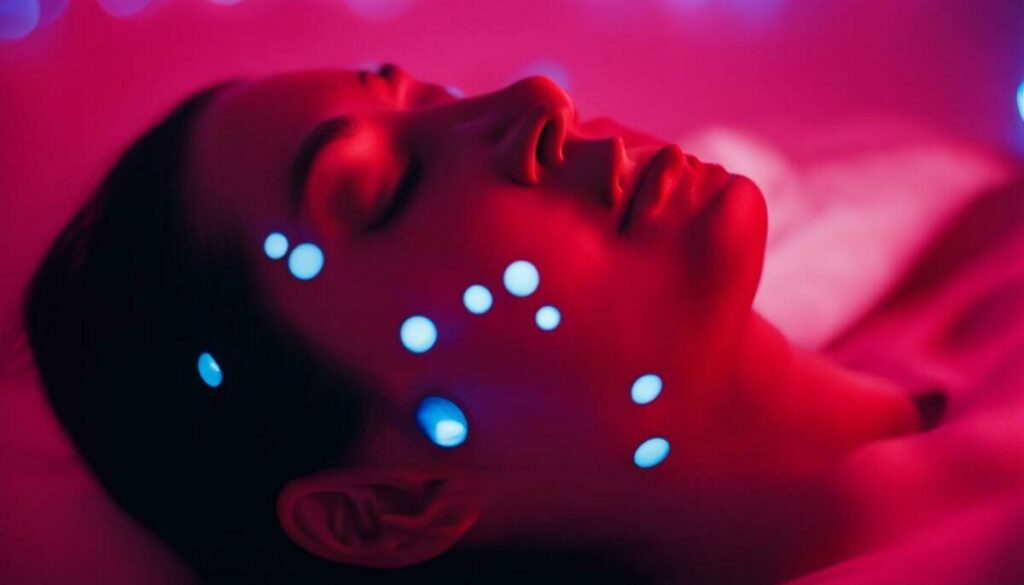
Blue and Red Light Therapy Devices for Skin
When selecting a blue or red light therapy device, it’s important to consider factors such as intensity, wavelength, and ease of use. Handheld devices are a popular option for at-home use, while spas and dermatologists may offer more intense professional treatments.
It’s also important to follow the manufacturer’s instructions and to start with a lower intensity level before gradually increasing. This can help minimize the risk of potential side effects such as temporary redness or skin sensitivity.
Incorporating blue and red light therapy into your skincare routine can be a game-changer for improving your skin’s appearance, reducing acne, and combating signs of aging. By following the tips and guidelines outlined in this guide, you’ll be well on your way to mastering the use of blue and red light therapy for optimal results.
Incorporating Blue and Red Light Therapy for Pain Relief
If you suffer from chronic pain, you know how challenging it can be to find relief. Fortunately, blue and red light therapy is a safe and effective option that can help manage pain and reduce inflammation.
Blue light therapy works by activating certain enzymes in the body, which then produce natural painkillers called endorphins. This process can help reduce discomfort and promote relaxation. Red light therapy, on the other hand, penetrates deeper into the body and has been shown to reduce inflammation and stimulate the production of collagen, which can aid in healing.
To incorporate blue and red light therapy into your pain management routine, you can use devices such as light panels, masks, or handheld devices. The duration and frequency of your therapy sessions will depend on the severity of your pain and the device you’re using. You can typically start with a few minutes per session and gradually increase the time as needed.
It’s essential to follow proper safety precautions when using these therapies. You should never shine the light directly into your eyes, and you should avoid using these therapies if you’re pregnant or have certain medical conditions.
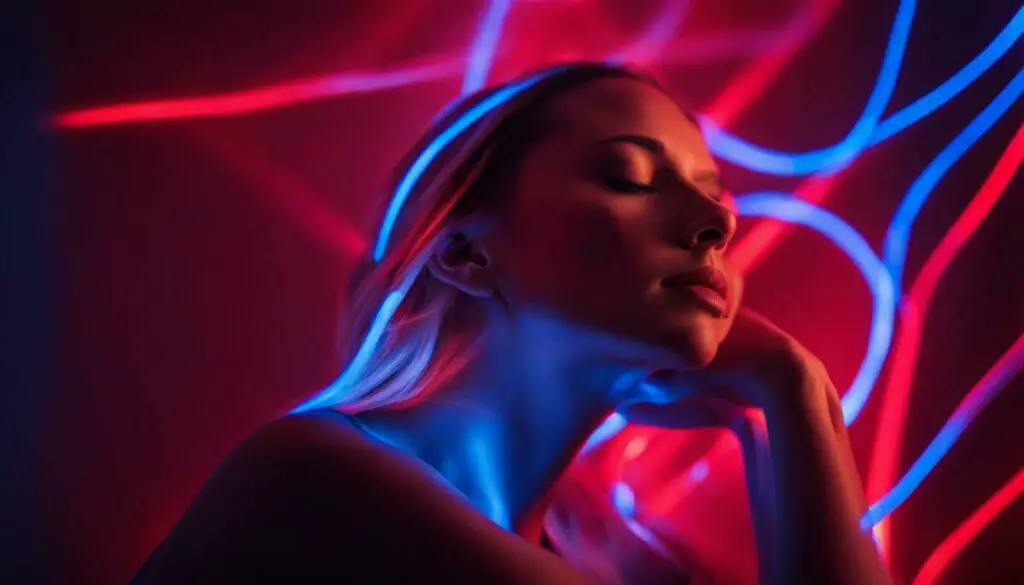
Incorporating Blue and Red Light Therapy for Pain Relief – Tips
- Use a high-quality, medical-grade device for best results.
- Consult with a healthcare professional before starting any new pain management routine.
- Be consistent with your therapy sessions and adhere to the recommended duration and frequency.
- Avoid shining the light directly into your eyes and protect your skin with a barrier such as a towel.
“I have struggled with chronic pain for years and was looking for a natural alternative to medication. Incorporating blue and red light therapy into my routine has been a game-changer. I’ve noticed a significant decrease in pain and inflammation and am grateful for this safe and effective option.” – Sarah, 38
Enhancing Sleep Quality with Blue and Red Light Therapy
If you’re looking for a non-invasive and natural solution to improve your sleep quality, blue and red light therapy may be the answer. Studies have shown that these therapies can help regulate your sleep-wake cycle, increase melatonin levels, and promote relaxation.
Red light therapy has been found to promote a deeper sleep and reduce the number of times you wake up during the night. This can lead to feeling more rested and alert in the morning. Blue light therapy, on the other hand, can help increase alertness and improve daytime performance, helping you stay awake during the day and fall asleep more easily at night.
When incorporating blue and red light therapy into your sleep routine, it’s important to use the therapies at the right time. Red light therapy is best used in the evening, about an hour before bedtime, while blue light therapy should be used during the day or in the morning to help regulate your circadian rhythm.
To create a relaxing environment, it’s recommended to use the therapies in a dimly lit or dark room. You can also combine the therapies with other relaxation techniques, such as deep breathing, meditation, or aromatherapy, to enhance their effectiveness.
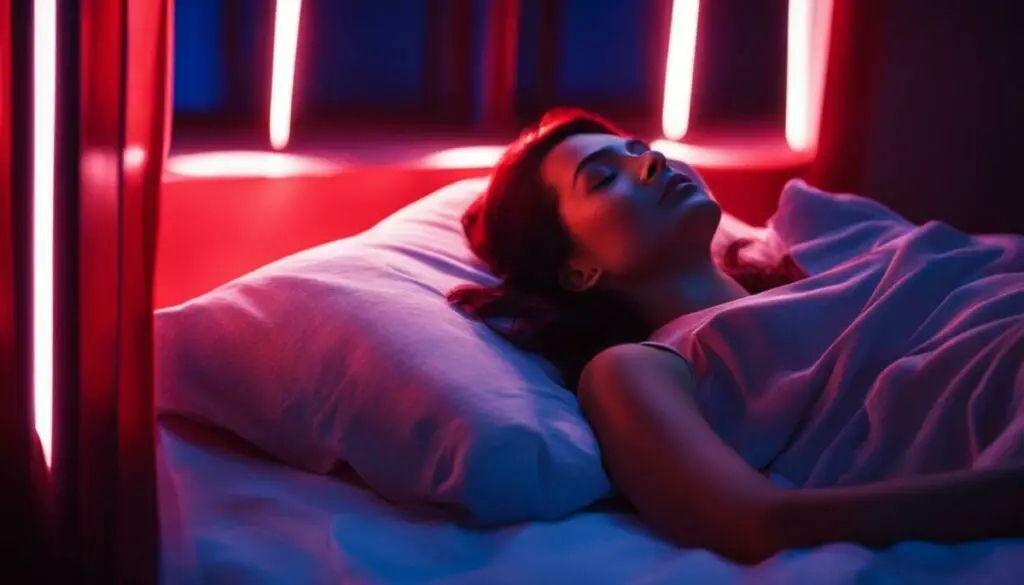
Enhancing Sleep Quality with Blue and Red Light Therapy: Tips to Remember
- Use red light therapy about an hour before bedtime to promote relaxation and a deeper sleep.
- Use blue light therapy during the day or in the morning to help regulate your circadian rhythm.
- Create a relaxing environment by using the therapies in a dimly lit or dark room.
- Combine the therapies with other relaxation techniques, such as deep breathing or aromatherapy, to enhance their effectiveness.
Choosing the Right Blue and Red Light Therapy Devices
With many blue and red light therapy devices available in the market, finding the right one for your needs can be overwhelming. Consider the following factors when selecting a device:
- Intensity: Choose a device with an appropriate level of intensity for your needs. Higher intensity devices may offer faster results, but may also cause skin irritation or discomfort.
- Wavelength: Ensure the device emits the correct wavelength for the therapy you’re seeking. Blue light therapy typically uses wavelengths between 405 to 420 nm, while red light therapy uses wavelengths between 630 to 660 nm.
- Size and Shape: Consider the size and shape of the device to ensure it’s easy to use and targets the desired area effectively. For instance, a smaller, handheld device may be more suitable for facial treatments.
- Cost: Choose a device that fits your budget while meeting your needs. Keep in mind that higher-priced devices may offer more features or benefits.
Check reviews and ratings before making a purchase to ensure the device is of good quality and has a solid reputation. Consider consulting with a healthcare provider or dermatologist before investing in a device to ensure it’s safe and appropriate for your needs.

Setting Up Blue and Red Light Therapy at Home
If you’re looking to experience the benefits of blue and red light therapy from the comfort of your own home, setting up your own at-home routine is surprisingly easy. By following a few simple steps, you can create an environment that is conducive to relaxation and optimal results.
Step 1: Choose the Right Device

Choosing the right device is crucial for effective light therapy at home. Look for devices that are specifically designed for at-home use and offer a range of wavelengths and intensities. Consider the size of the device, ease of use, and overall cost to ensure you make the right choice for your needs.
Step 2: Find a Comfortable Space
Find a quiet, comfortable space in your home where you won’t be disturbed during your light therapy sessions. Ideally, this space should be free from distractions and have a comfortable chair or surface to lie on. Try to eliminate any bright light sources that could interfere with the effectiveness of your session.
Step 3: Time Your Sessions
Timing is important when it comes to light therapy. Schedule your sessions at a time when you can fully relax and won’t be interrupted. Aim for 15-30-minute sessions, depending on the device you’re using and the specific benefits you’re targeting. Be consistent with your timing, and try to schedule sessions at the same time every day.
Step 4: Protect Your Eyes
It’s important to protect your eyes during light therapy sessions to avoid any potential damage. Invest in a pair of specially designed goggles that block out blue and red light. Alternatively, you can close your eyes during your session and cover them with a soft cloth or eye mask.
Step 5: Relax and Enjoy
Finally, relax and enjoy your time under the soothing glow of blue and red light. Set the mood with calming music or aromatherapy, and allow yourself to fully unwind. With consistent use, you’ll start to see the incredible benefits of at-home blue and red light therapy.
Preparing for Blue and Red Light Therapy Sessions
Proper preparation is essential to ensure you get the most out of your blue and red light therapy sessions. Follow these steps to maximize your results:
- Cleanse your skin: Before each session, cleanse your skin thoroughly with a gentle cleanser. This will remove any dirt, oil, or makeup, which can interfere with the effectiveness of the therapy.
- Protect your eyes: Blue and red light therapy can be damaging to your eyes if directly exposed. Wear protective goggles or close your eyes during your session to prevent any harm.
- Create a relaxing environment: Find a quiet and comfortable space to perform your therapy. Consider dimming the lights or playing soothing music to help you relax and reap the full benefits of your session.
By following these simple steps, you can ensure you are properly prepared for your blue and red light therapy sessions and achieve the best possible results.

Understanding the Duration and Frequency of Light Therapy Sessions
Now that you understand the benefits and how to use blue and red light therapy, it’s essential to know the right duration and frequency of each session. For skin concerns, experts recommend using blue or red light therapy for 15-20 minutes, two to three times per week for visible results. If you’re using light therapy for pain relief, it’s recommended to use it for around 30 minutes per day, three to five times per week.
For sleep improvement, use blue light therapy in the morning for approximately 30 minutes to regulate your circadian rhythm and red light therapy at night for 20-30 minutes to promote relaxation and enhance melatonin production.
It’s important not to overdo light therapy sessions, as extended exposure may lead to negative effects. Adhere to the recommended frequency and duration for each therapy session and keep track of your progress to determine the optimal routine that works for you.
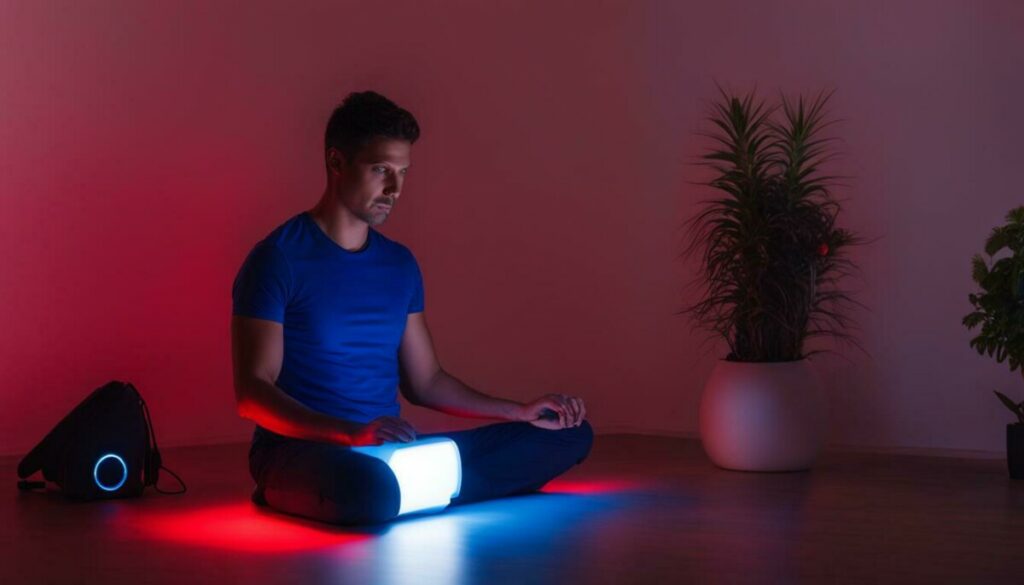
It’s worth noting that consistency is key when it comes to light therapy. Incorporating blue and red light therapy into your daily routine, even for short sessions, can be more effective than occasional, longer sessions. By ensuring you stick to a regular routine, you can create a sustainable habit that offers maximum benefits.
Incorporating Blue and Red Light Therapy into Your Daily Routine
Integrating blue and red light therapy into your daily routine is simple and easy. Consistency is essential to achieving optimal results, so find a routine that works for you and stick to it. Here are some practical tips for incorporating these therapies into your daily regimen:
- Start small: If you’re new to light therapy, start with shorter sessions and gradually increase the duration as you become more comfortable.
- Choose the right time: Blue light therapy is best utilized during the daytime while red light therapy can be used at any time of day. Consider your schedule and choose a time that works best for you.
- Find a comfortable space: Creating a relaxing environment is key to getting the most out of your therapy sessions. Find a quiet, comfortable space where you can relax and unwind.
- Protect your eyes: Always wear protective goggles or glasses during your blue and red light therapy sessions to prevent eye damage.
- Cleanse your skin: Before each session, make sure to properly cleanse your skin to remove any makeup, dirt, or oils that may interfere with the therapy.
- Use targeted therapy: Depending on your specific concerns, you may want to target specific areas of your body. Experiment with using blue and red light therapy on different areas to find what works best for you.
- Be consistent: To achieve the best results, it’s important to use blue and red light therapy consistently. Incorporate it into your daily routine and stick to it, even if it’s just for a few minutes each day.
Following these tips will help you seamlessly incorporate blue and red light therapy into your daily life, providing optimal results for your skin, mood, and overall health.
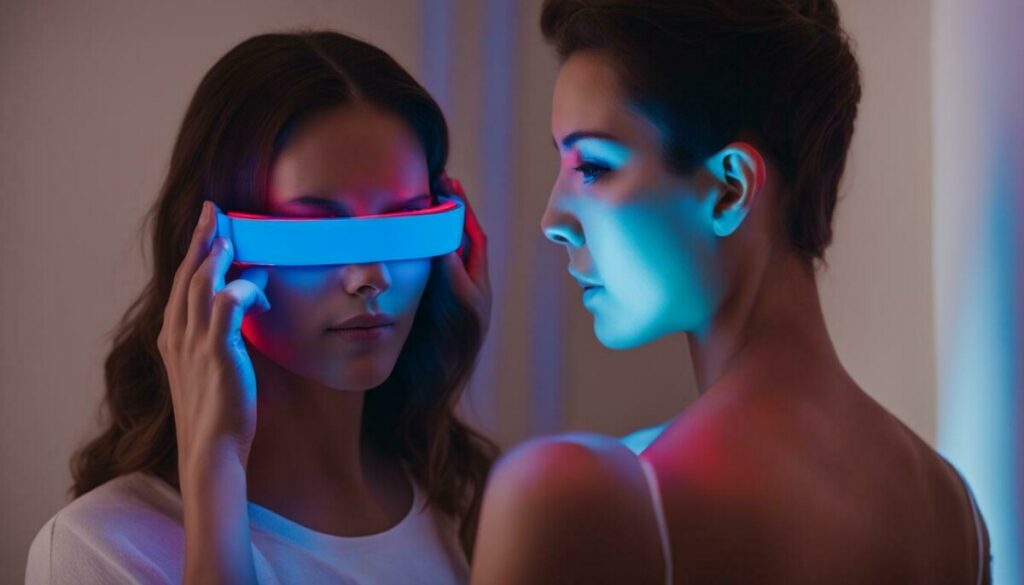
Monitoring and Assessing Your Progress
As you incorporate blue and red light therapy into your daily routine, it’s essential to monitor your progress and make adjustments as necessary. Here are some tips to help you assess the effectiveness of your light therapy sessions:
- Take before and after photos to track changes in your skin’s appearance
- Keep a journal to record changes in your mood, energy levels, and sleep quality
- Observe changes in pain levels and inflammation
By regularly monitoring your progress, you can make informed decisions about the frequency and duration of your light therapy sessions. It’s important to note that results may vary and may take several weeks or months to become noticeable. Consistency is key, so stick to your routine and give your body time to respond.
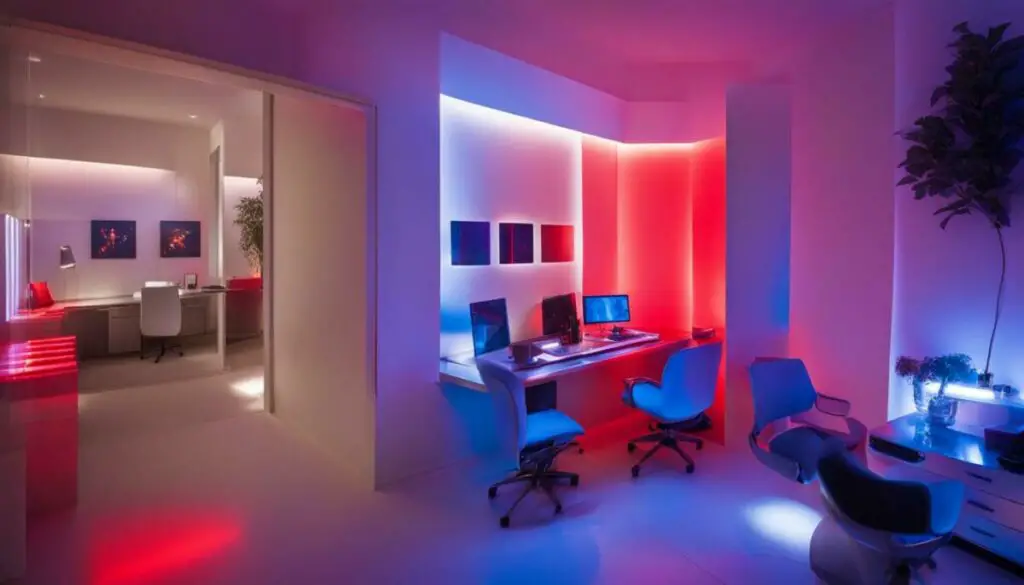
Tip:
Consider keeping a light therapy journal to document your progress and make any necessary changes to your routine. This will help you stay organized and on track.
Combining Blue and Red Light Therapy with Other Skincare Practices
If you are already incorporating a variety of skincare practices into your daily routine, consider adding blue and red light therapy to enhance their effectiveness. These therapies can work in tandem with many other skincare treatments and practices, including:
- Facial massages
- Exfoliation
- Topical acne treatments
- Moisturizing
One effective strategy is to perform a facial massage with a light, non-comedogenic oil before beginning your blue or red light therapy session. This can help stimulate blood flow and prepare your skin for optimal light therapy absorption. You can also exfoliate prior to your session to remove dead skin cells, allowing the light to reach deeper into your skin. Topical acne treatments can also be used in conjunction with blue light therapy to enhance their effectiveness.
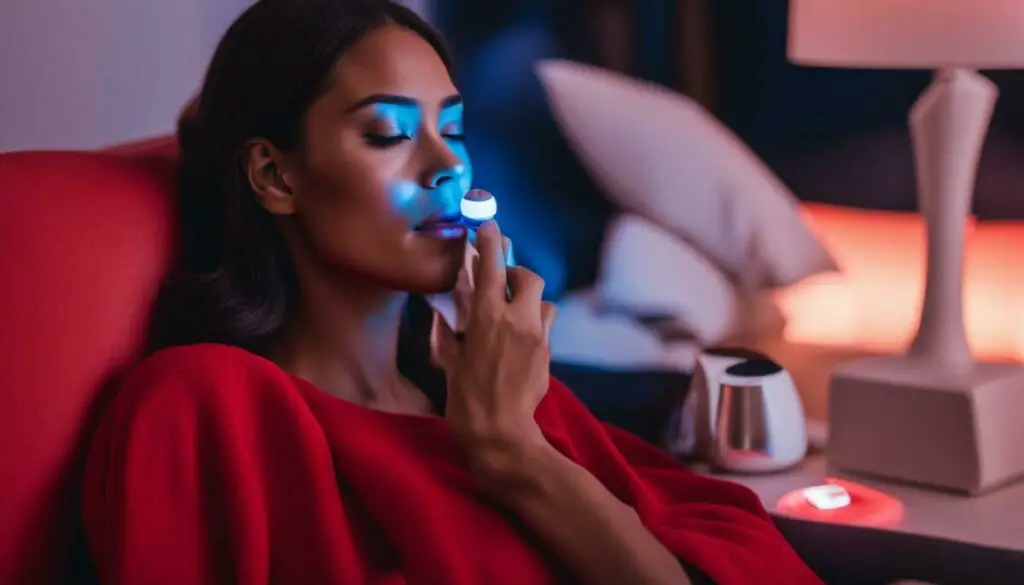
After your light therapy session, make sure to moisturize to keep your skin hydrated and protected. This can help prevent any dryness or irritation that might occur from the light therapy. Consider incorporating a gentle, fragrance-free moisturizer into your routine to provide your skin with the nourishment it needs.
By combining blue and red light therapy with other skincare practices, you can create a holistic approach to achieving your skincare goals. Experiment with different combinations and find the routine that works best for you.
Understanding the Potential Side Effects and Precautions
While blue and red light therapy is generally safe and non-invasive, it’s important to be aware of potential side effects. These are typically mild and temporary, and may include:
- Temporary redness or swelling of the skin
- Dryness or flakiness
- Temporary changes in skin texture or color
- Eye strain or discomfort (if eyes are not properly protected)
To avoid these side effects, it’s essential to take necessary precautions when using blue and red light therapy. These include:
- Using the therapy as directed by the manufacturer or a healthcare professional
- Protecting your eyes with goggles or eye shields during each session
- Avoiding prolonged exposure or using higher intensities than recommended
- Performing a patch test before applying the therapy to a large area of skin
It is also important to note that certain individuals may not be suitable candidates for blue and red light therapy. These include:
- Individuals with photosensitivity or epilepsy
- Women who are pregnant or breastfeeding
- Individuals with a history of skin cancer or lesions
- Individuals taking medications that increase sensitivity to light
Always consult with your healthcare provider before starting any new therapy and discuss any concerns or questions you may have about blue and red light therapy.
Remember, proper use and precautions can help ensure a safe and effective light therapy experience.

Exploring the Scientific Evidence Behind Blue and Red Light Therapy
Blue and red light therapy may seem like a new trend, but the science behind these therapies has been studied for decades. Researchers have explored the mechanisms of action and clinical efficacy of blue and red light therapy in a variety of contexts.
For example, a 2016 study published in the Journal of Clinical and Aesthetic Dermatology found that blue light therapy was effective in reducing inflammatory acne lesions. Another study, published in the International Journal of Cosmetic Science, demonstrated that red light therapy improved skin texture and reduced the appearance of fine lines and wrinkles.
Research has also shown the potential of blue and red light therapy for pain relief. A 2012 study published in the journal Pain Research and Treatment found that red light therapy significantly reduced pain for patients with knee osteoarthritis.
Additionally, studies have explored the use of blue and red light therapy for sleep regulation and improvement. A 2017 study published in PLoS One found that red light therapy improved sleep quality and reduced symptoms of insomnia in study participants.

While more research is needed to fully understand the mechanisms of action and effectiveness of blue and red light therapy, the existing scientific evidence is promising. By incorporating these therapies into your daily routine, you may experience the numerous benefits supported by research.
User Success Stories: Real-Life Experiences with Blue and Red Light Therapy
Over the years, many individuals have incorporated blue and red light therapy into their lives and experienced its benefits firsthand. From improving skin appearance to relieving pain and enhancing sleep quality, these therapies have helped countless people achieve their health and wellness goals. Here are some success stories from real users who have mastered how to use blue and red light therapy:
“I struggled with acne for years, and nothing seemed to work. Then I discovered blue light therapy, and it was a game-changer. After just a few sessions, I noticed a significant improvement in my skin’s appearance. Now, I use it regularly to maintain healthy, clear skin.”
– Jessica, 28
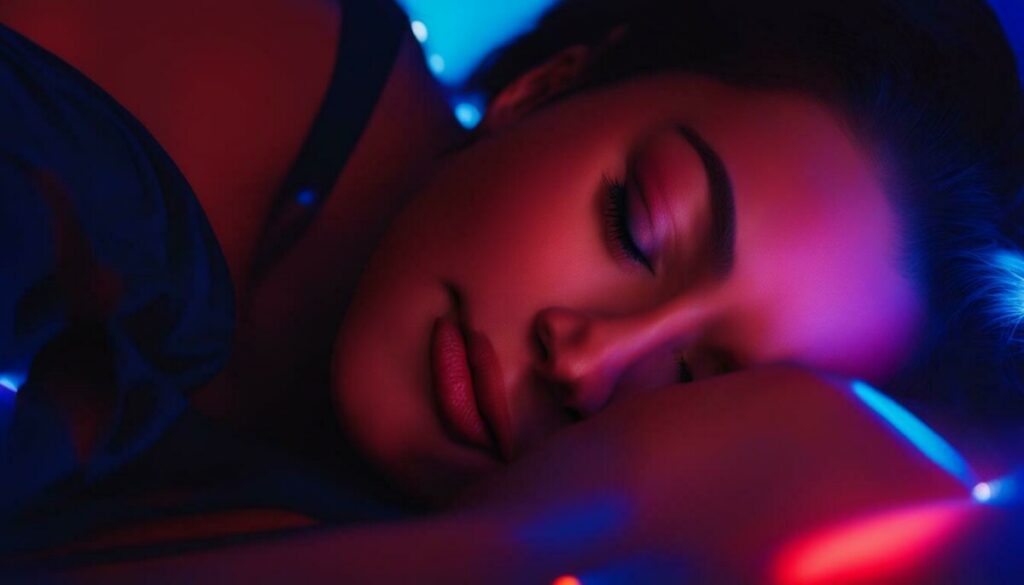
“As someone who suffers from chronic pain, I’m always looking for natural ways to manage my symptoms. Red light therapy has been a lifesaver for me. It’s helped reduce my pain and inflammation, allowing me to enjoy a more active lifestyle.”
– David, 45
“I’ve struggled with sleep issues for as long as I can remember. But since incorporating blue and red light therapy into my bedtime routine, I’ve noticed a significant improvement in the quality of my rest. I feel more rested and energized throughout the day.”
– Sarah, 32
These are just a few examples of the many success stories associated with blue and red light therapy. By following the guidelines and recommendations provided in this guide, you too can experience the amazing benefits of these therapies.
Conclusion
Using blue and red light therapy can be a game-changer for your skincare, mood, and overall health. By understanding the benefits of these therapies and following the guidelines provided in this guide, you can effectively incorporate them into your daily routine for optimal results.
Remember to choose the right devices for your needs, set up a comfortable and effective environment for your sessions, and take necessary precautions to ensure safe use. Monitor your progress and assess your results to make informed decisions for your light therapy routine.
Combining blue and red light therapy with other skincare practices can enhance their effectiveness, and it’s important to maintain consistency to achieve maximum benefits. Start your light therapy journey today and experience the positive outcomes for yourself!
Keep Learning and Experimenting!
As scientific research continues to explore the mechanisms and benefits of blue and red light therapy, new findings and devices may emerge. Stay up to date with the latest advancements and continue experimenting with your routine to find what works best for you.
Thank you for reading, and we wish you the best on your journey to mastering how to use blue and red light therapy effectively!
FAQ
How does blue light therapy treat acne?
Blue light therapy targets the bacteria that cause acne, reducing inflammation and promoting healing. It is a non-invasive and chemical-free treatment that can effectively improve acne breakouts.
Can red light therapy help with pain relief?
Yes, red light therapy has been shown to reduce pain and inflammation by increasing blood flow and promoting tissue repair. It can be used to manage various types of pain, including arthritis, muscle soreness, and joint stiffness.
How long should I use blue and red light therapy for skin benefits?
The recommended duration for blue and red light therapy sessions varies depending on the specific skin concern. Generally, starting with 10-20 minutes per day and gradually increasing the duration is recommended. It’s important to follow the manufacturer’s instructions and consult a healthcare professional if needed.
Can I use blue and red light therapy for anti-aging?
Yes, both blue and red light therapy have anti-aging benefits. Blue light therapy improves skin texture and reduces acne, while red light therapy stimulates collagen production, reducing fine lines and wrinkles. Using both therapies in combination can help achieve a more youthful appearance.
How often should I use blue and red light therapy for pain relief?
The frequency of blue and red light therapy sessions for pain relief depends on the severity and nature of the pain. Starting with 2-3 sessions per week and adjusting based on your response is recommended. It’s important to listen to your body and consult a healthcare professional for personalized advice.
Can blue and red light therapy improve sleep quality?
Yes, blue and red light therapy can help regulate your sleep-wake cycle and improve the quality of your sleep. Using blue light therapy in the morning can energize you and promote wakefulness, while red light therapy in the evening can encourage relaxation and prepare your body for sleep.
How do I choose the right blue and red light therapy device?
When selecting a device, consider factors such as the specific skin concern you want to address, intensity settings, and ease of use. Look for FDA-cleared devices and read customer reviews to ensure you’re choosing a reputable option.
What precautions should I take before using blue and red light therapy?
Before each session, make sure to cleanse your skin thoroughly and remove any makeup or lotions. Protect your eyes with goggles or by keeping them closed throughout the session. Create a comfortable and relaxing environment to enhance the effectiveness of the therapy.
How long does it take to see results from blue and red light therapy?
The time it takes to see results from blue and red light therapy varies depending on the specific skin concern and individual response. Some people may experience improvements within a few weeks, while others may require longer. Consistency and following a proper routine are key factors in achieving optimal results.
Can I combine blue and red light therapy with other skincare practices?
Yes, blue and red light therapy can be used in combination with other skincare practices to enhance their effectiveness. For example, incorporating light therapy after cleansing and before applying serums or moisturizers can maximize the absorption of these products.
Are there any side effects of blue and red light therapy?
Blue and red light therapy are generally safe, but some individuals may experience mild side effects such as temporary redness or dryness. Following the recommended guidelines and consulting a healthcare professional if you have any concerns can help minimize potential side effects.
Is there scientific evidence supporting the effectiveness of blue and red light therapy?
Yes, numerous clinical studies have demonstrated the benefits of blue and red light therapy for various skin concerns, pain relief, and sleep regulation. Understanding the scientific evidence can provide reassurance and confidence in incorporating these therapies into your routine.
Certainly! We have received feedback from individuals who have used blue and red light therapy and had positive experiences in improving their skin, reducing pain, and enhancing sleep quality. These real-life stories can inspire and provide insights into the potential benefits of these therapies.

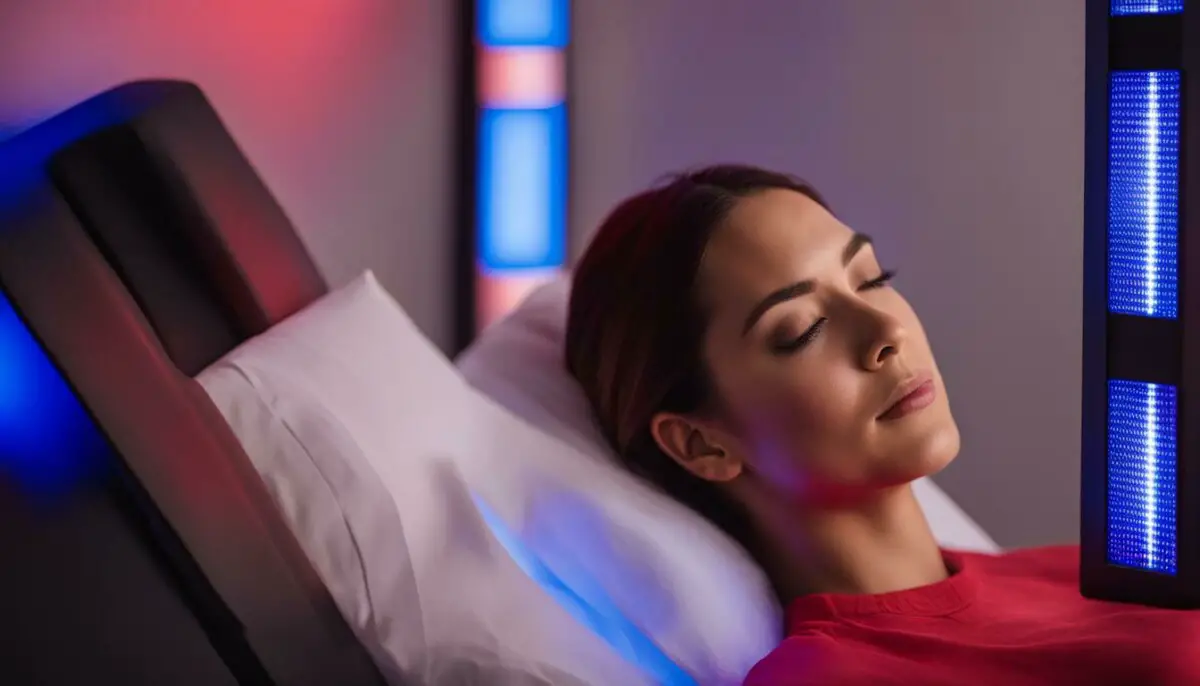


.jpg)



